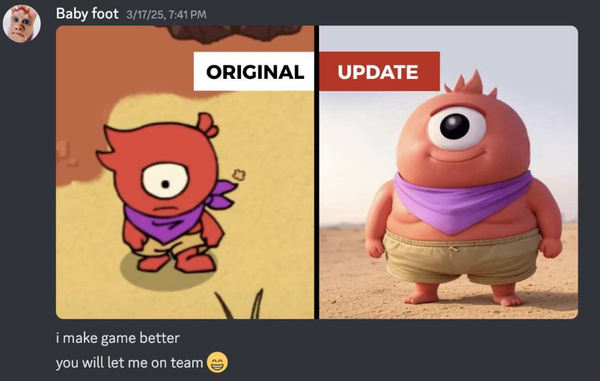Goodbye, Snake Bart
Also: cursed collabs, submerged animatronics, and Furbies.

EX is a research report about where culture is headed. You can learn more here. This week, we’re talking about anything but Palworld.
1. Tumblr Live is Tumblr dead

The misbegotten experiment of Tumblr Live came to an end on January 24, 2024. The hypothesis that you could introduce new streamer lifeforms into an environment that sustains only Supernatural-based organisms was disproven. If you were ever curious enough to check out the social network’s foray into livestreaming, which almost no one was, you were greeted with a sea of interchangeable thumbnails for porn-y looking streams interrupted by the occasional face of Some Dude. Besides the two guys immortalized here by comedian wayneradiotv (who were maybe renamed for comic effect — Didley Bags was streaming when we checked, but under a different name) the streamers of Tumblr Live seem to have left this digital coil without making any impression on anyone.
Tumblr users really hated Live (2022-24) for adding an icon to the dashboard they couldn’t remove, although it could be “snoozed,” a concession that enraged many. Most Tumblr posts about the death of Live were celebrations of never looking at it. Even a post begging for anyone with “ANY experience” of watching Live to describe it went unanswered. The only fond remembrance to be found anywhere was in the Live-killing memo from parent company Automattic in late 2023, which said, among other things, “It is better to have loved and lost than never to have loved at all.”
One of the few people with “ANY experience” of Live was YouTuber STRANGE ÆONS, who checked it out last year. She described it as a mix of “hot women in your area” renaming their accounts after being banned, people with cameras pointed at their walls, and “Tumblr users from 10 years ago.”
2. Spotify data is the new Myers-Briggs

Spotify announced a 20,000% increase in usage of its “daylist” feature, which generates a custom playlist based on your listening habits each morning and afternoon and which, crucially, comes accompanied by an algorithmically written no-caps title like “floaty r&b thursday morning” or “midwest emo flannel tuesday early morning.” You can find yours by searching “daylist” on the platform, or clicking here, after which you are almost biologically compelled to share it. (This writer got “beats underground music for this moment,” thus perpetuating the curse.)
Daylists launched in September but exploded in popularity over the past week thanks to a viral Instagram challenge that demanded, “Don't tell me your astrological sign; I want you to go into Spotify, search for your daylist, and post the title it gave you.” Much of the feature’s power comes from its titles, which can be playful, esoteric, even teasing, roping in references to art deco and self-sabotage and almost judging the user with a sense of coy big-data authority. In the same way that the TikTok algorithm famously anticipates a user’s web of interests from their swiping habits, the Spotify algorithm seems to reflect deeply ingrained habits of use that echo the user’s real personality, faults and all.
It also reflects the sea change in music consumption that Spotify itself instigated over the past decade or so. As limitless music listening has become essentially free, people have found more utilitarian uses for it, consuming much more music than they might have previously but frequently doing so passively, as one algorithmic recommendation folds into the next. As a result, each user, too, has more complicated clouds of data accruing in their wake. This is why the Spotify Wrapped feature remains a global phenomenon when it drops, while other platform’s year-end data recaps — like Netflix or Steam — feel less ethereal and personalized. Like horoscopes, Harry Potter quizzes, and Myers-Briggs classifications, Spotify’s big data reflections trumpets each user’s uniqueness — even if all they’re doing is listening to the same Olivia Rodrigo songs everyone else is.
3. The Persona curse kills another gacha game

For fans of gacha games, the Persona collab has become a harbinger of doom for a genre steeped in copious crossover events. Star Ocean: Anamnesis, Sword Art Online: Memory Defrag, Dragalia Lost, and Fullmetal Alchemist Mobile each shut down their services roughly a year after featuring Persona crossovers, leading fans to joke that Persona “kills” mobile games with every collaboration. (In the image above, “EOS” stands for “end of service.”) Players originally noticed the trend after Dragalia Lost shut down in 2022.
NieR Re[in]carnation, a free-to-play mobile game set in Yoko Taro’s Drakengard / NieR universe, is the latest to fall prey to Persona’s “curse.” In true NieR fashion, the game is shutting down a month after the final chapter’s release date in March — well over a year after their own Persona 5 collab. If the curse is to be believed, you might not want to visit a Wendy’s in Japan until a couple of years after their Persona 3 Reload collab has finished.
4. The primordial horror of submerged animatronics

The small subreddit r/submergedanimatronic is exactly what you think it is: “wet robot scary.” It collects videos and photos of decaying amusement park rides whose once-goofy water monsters now look like withered revenants. The worst of these are bunyip animatronics from Australia’s amusement parks: Bertha the Bunyip (this footage was once believed to be lost, and perhaps should have been) and the Ettamagoah Bunyip. It’s unclear whether redditors are really frightened by these or just nostalgic for childhood terrors. Surprisingly, aquatic animatronics don’t seem to have been mined for scares by the Five Nights at Freddy games or their mascot horror ripoffs; however, they did make it into a tie-in novel.
5. Another “bodycam FPS” makes waves on YouTube
Bodycam, a photorealistic FPS played from the perspective of a police officer’s bodycam, started making the rounds on YouTube a few days ago after the devs held a private alpha test. Though similar in concept, Bodycam should not be confused with Unrecord, a different “bodycam FPS” that initially went viral in late 2022; unlike Unrecord, which revolves around a single-player narrative, Bodycam is PVP-focused. Alpha participants tested the game’s take on team deathmatch.
The YouTubers who were invited to Bodycam’s alpha largely came away with the same impression: Its commitment to Unreal Engine 5-driven realism is both a strength and a weakness, enabling highly detailed environments while restricting camera movement and locomotion. Reception to Bodycam seems to indicate that, despite Unreal Engine 5’s robust toolset, photorealism requires compromise.
Chum Box
- While Barbie’s purported “Oscars snub” generated one of the worst tweets of all time, May December’s snub actually only reinforced that movie’s greatness. (Please watch May December.)
- The 21-year-old dev behind indie megahit Lethal Company, Zeekerss, gave a rare interview to Push to Talk that broke down the game’s development. (via GameDiscoverCo)
- The subreddit r/onlyfans had long ago transformed from a NSFW sub into a joke board for posting pictures of fans (“of the air-moving variety”). This week, a rogue mod tried to hijack the sub and turn it NSFW again; after word got out, the coup was thwarted and a new mod team was installed.
- An odd-looking poster in the background of True Detective was spotted by Twitter users who speculated that it was AI-generated. Showrunner Issa López confirmed that the poster was made using AI, but claimed it was an intentional choice with narrative justification.
- The NSA’s Furby investigation is the stuff of internet legend. The agency’s internal documents have finally been revealed thanks to a cheeky FOIA request.
- Frosty Faustings, the Midwest’s big fighting game tournament, runs through this weekend. Tekken 8 just came out yesterday, but there’ll a “preview tournament” for it on Sunday, which should be interesting.
- The maker of the Elden Ring seamless co-op mod has been cooking up a co-op mod for Armored Core 6 — YouTuber Oroboro tested it here.
- Gen Z drawn to liminal spaces IRL.
- A crypto pastor sold his flock 1.3 million dollars of godcoins.
- Dragon’s Dogma 2’s director ruffled feathers with an inflammatory comment about fast travel, which he considers “boring.” (See our crosstalk on Starfield.)
That’s it for this week. We’ll be practicing our Korean backdash until next week.






